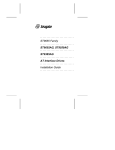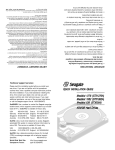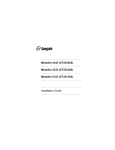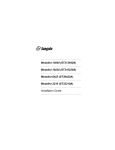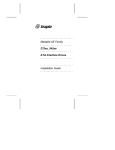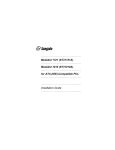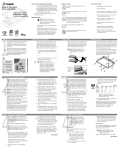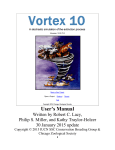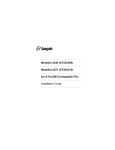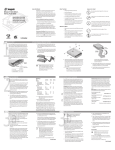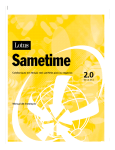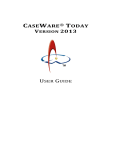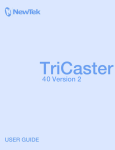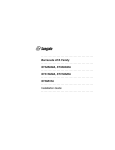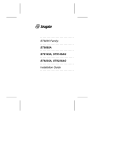Download Seagate MARATHON 810 Installation guide
Transcript
.......................... Marathon 810 (ST9816AG) .......................... ATA Interface Drive .......................... .......................... .......................... Installation Guide .......................... Contents Read before you begin... . . . . . . . . . . . . . . . . . . 1 Hardware Configuration . . . . . . . . . . . . . . . . . .2 Configuring the drive . . . . . . Attaching cables . . . . . . . . Mounting the drive . . . . . . . Software and system configuration . . . . . . . . . . . . . . . . . . . . . . . . . . . . . . . . . . . . . . . . . . . . .2 .3 .3 .5 About Disk Manager software . . Configuring your system BIOS . . Installing Disk Manager . . . . . . Manual formatting and partitioning Partitioning . . . . . . . . . . . . Installation troubleshooting . . . . . . . . . . . . . . . . . . . . . . . . . . . . . . . . . . . . . . . . . . . . . . . . . . . . . . . . . . . . . . . . . .5 .7 .8 10 10 12 General troubleshooting procedures . Specific Troubleshooting Procedures . Compatibility notes . . . . . . . . . . Technical support services . . . . . . . . . . . . . . . . . . . . . . . . . . . . . . . . . . . . . . . . 12 14 18 19 Storing and shipping your drive . . . . . . . . . . . . . 22 ©1996 Seagate Technology, Inc. All rights reserved Publication Number: 36336-201, Rev. A, February 1996 Seagate, Seagate Technology, the Seagate logo, SeaFAX, SeaFONE and SeaBOARD are registered trademarks of Seagate Technology, Inc. SeaTDD is a trademark of Seagate Technology, Inc. Other product names are registered trademarks or trademarks of their owners. Seagate reserves the right to change, without notice, product offerings or specifications. No part of this publication may be reproduced in any form without written permission from Seagate Technology, Inc. Marathon 810 Installation Guide, February 1996 1 Read before you begin... Caution. Do not partition or format this drive before removing the free Disk Manager software that is stored on the drive. Without this software your computer may not be able to access the full capacity of the Marathon 810. For details, see “About Disk Manager software” on page 5. Note. To use the free Disk Manager software that is provided on this drive, you need a bootable DOS system diskette and a blank 1.4-Mbyte diskette. Static discharge. Observe the following precautions: • Before handling any components, put on a grounded wrist strap. • Use antistatic padding on all work surfaces. • Avoid static-inducing carpeted areas. • Keep the drive in its static-shielded bag until you are ready to complete the installation. Do not attach any cables to the drive while it is in its static-shielded bag. • Handle the drive by its edges or frame. • Do not touch the I/O connector pins or the circuit board. Drive handling. The drive is extremely fragile—handle it with care. Do not attach labels to any part of the drive. Inspection. Observing the static-discharge and handling precautions listed above, inspect the drive. If it appears to be damaged, call your distributor or dealer immediately. Maintenance and repair. Seagate® drives do not require maintenance. The head/disc assembly is sealed; if you break the seal, 2 Marathon 810 Installation Guide, February 1996 you void the warranty. Seagate customer service centers are the only facilities authorized to repair Seagate drives. Seagate does not sanction any third-party repair facilities. Warranty. See your authorized Seagate distributor or dealer. With regard to Disk Manager and SEG32BIT.386 software, there are no warranties, express or implied, including warranties of merchantability or fitness for a particular purpose. All such warranties are expressly and specifically disclaimed. Application. This drive uses the ATA interface and is designed for IBM AT and compatible personal computers. It is intended for use with UL-listed computers or similar products. Hardware Configuration Configuring the drive 1. Put on a grounded wrist strap. Wear the grounded wrist strap throughout the installation procedure. 2. Install master/slave jumpers. In a two-drive system, you need to designate one drive as the master, or drive 0, and the other drive as the slave, or drive 1. To do this, install the master/slave jumpers as shown in Figure 1. In a one-drive system, configure the drive as a master (no jumpers installed). Alternatively, you can configure the drive as a master or slave using the cable select option. Cable selection requires a special drive interface cable that grounds pin 28 (CSEL) on one of its two drive connectors. If you attach the drive to the grounded CSEL connector, it becomes a master. If you attach the drive to the ungrounded CSEL connector, it becomes a slave. To use this option, the host system and both drives must support cable select, and both drives must be configured for cable select. To configure a Marathon 810 Installation Guide, February 1996 3 Marathon 810 for cable select, install both master/slave jumpers, as shown in Figure 1 on page 4. Attaching cables This drive is designed for a host computer that supplies interface signals and +5V power through a single 44-pin connector and cable. If your computer has a fixed connector that attaches directly to the drive, skip ahead to the following section, “Mounting the drive.” Otherwise, attach the interface/power cable as described below. 1. Turn off the computer and remove the battery. 2. Put on a grounded wrist strap. 3. Open your computer case. See your system manual for instructions. Caution. Special training or tools may be needed to service laptop and notebook computers. In some cases, opening the case may void your warranty. 4. Connect the 44-pin interface/power cable. Match pin 1 of the cable to pin 1 of the interface connectors on the drive and on the computer. Pin 1 is usually denoted by a stripe along one edge of the cable. The location of pin 1 on the drive interface connector is shown in Figure 1 on page 4. The cable should be no longer than 18 inches (0.457 meters). Caution. The printed-circuit cables used in laptop computers are very delicate. Be careful not to tear them. Mounting the drive Mount the drive securely in the computer using M3X0.5 metric screws in the four bottom mounting holes or the four side mounting holes. You can mount the drive in any orientation. Be careful not to strain or crimp the interface/power cable. 4 Marathon 810 Installation Guide, February 1996 Note. Drive is shown with circuit board up. Master/slave Pin 1 configuration jumpers Pin 20 removed for keying Circuit board B A D C Drive is master; slave may be detected using DASP– signal Drive is master; Seagate slave drive present Drive is slave; Seagate master drive present Use CSEL pin grounding to differentiate master from slave Figure 1. ATA interface connector and master/slave configuration jumpers Marathon 810 Installation Guide, February 1996 5 Caution. To prevent damage to the drive while mounting, take the following precautions: • Be careful not to bend the drive connector pins, especially when plugging the drive into a fixed connector. • Use mounting screws of the correct size and length. • Gently tighten the mounting screws—do not apply more than 3 inch-pounds of torque. • Do not insert mounting screws more than 0.15 inches into the mounting holes. Note. This drive meets industry-standard MCC mounting specifications. When installing this drive in a fixed-mounting application, you must use MCC-compatible connectors and mounting hardware. If the mounting holes in your computer do not line up with the mounting holes on the drive, your computer may not be MCC-compatible. Software and system configuration About Disk Manager software Many DOS-based computers cannot access more than 528 Mbytes on a single drive unless the host system: • supports and is configured for LBA addressing or for extended CHS addressing, or • contains a specialized drive controller, or • runs BIOS-translation software. Seagate provides a BIOS-translation program, Ontrack Disk Manager, with the Marathon 810. This software not only allows older computers to access the full capacity of the drive, but can be used to rapidly partition and format the drive, even on newer computers that do not require BIOS-translation software. 6 Marathon 810 Installation Guide, February 1996 Before you can run the Disk Manager software you must transfer it from your new hard disc onto a blank, bootable diskette in drive A of your computer (the program can only be run from drive A). Creating a blank bootable diskette 1. Boot your computer using a bootable DOS system diskette or bootable hard drive that contains the DOS program FORMAT.COM. Note. You must use a single version of DOS throughout the installation and configuration process. 2. Type format a: /s then press ENTER. 3. Follow the instructions on the screen: Insert a new 1.4-Mbyte diskette into drive A, and then press ENTER. The formatting process may take several minutes. Transferring the Disk Manager software Note. Before you can transfer your Disk Manager software, you must set all jumpers, attach all cables, and mount your drive in the computer, as described on pages 2 through 5. 1. Reboot your computer using the blank, bootable diskette on which you plan to store the Disk Manager software. 2. Run your computer’s system setup program (sometimes called BIOS or CMOS setup). See your computer or motherboard manual for system-specific instructions. 3. Within the system setup program, configure your new hard drive as Drive Type 2, or enter the following values for a user-definable drive type: 615 cylinders, 4 heads, and 17 sectors per track. Note. These settings are temporary. They allow you to access the drive-support software on your new hard disc. Marathon 810 Installation Guide, February 1996 7 4. Reboot your computer again using the blank, bootable diskette. 5. You should now be able to access the software on your new hard disc. If your new hard drive is drive C, type c:\seamove to transfer the disc support software. Use a different drive letter if necessary. The SEAMOVE program transfers the drive-support files from your new hard disc to your blank, bootable diskette in drive A. After all the files have been transferred, SEAMOVE deletes all the files from the hard drive, along with the temporary partition that held them. You must then run Disk Manager from your bootable software diskette to access the full capacity of your drive. Configuring your system BIOS 1. Restart your computer (again!) from a bootable diskette, and enter your system setup program as described previously. 2. Within the system setup program, make sure that the correct drive type is listed for each ATA hard drive in your computer. Some newer computers can automatically determine drivetype characteristics if you select the Auto drive-type setting. If your computer does not provide this option, you must manually enter the number of cylinders, heads and sectors per track for your new drive, as shown in the table below. Cylinders 1,571 Heads 16 Sectors per track 63 Total sectors 1,583,568 Bytes per sector 512 Capacity 810.7 million bytes 8 Marathon 810 Installation Guide, February 1996 Note. The system setup program may request information on the drive’s write precomp or landing zone. You do not need to enter any values for these parameters because your Seagate drive does not use them. 4. Save your drive-type settings, exit the system setup program, and reboot your computer using the DOS diskette. Installing Disk Manager Note. If you do not want to use the Disk Manager software, turn to “Manual Formatting and Partitioning” on page 10. 1. Insert your bootable software diskette in drive A. 2. At the DOS prompt, type a:\dm and press ENTER to start Disk Manager. 3. Follow the instructions on your computer screen. From the main menu, select (E)asy Disk Installation and press ENTER. 4. At this point, Disk Manager lists all the ATA hard drives that it can recognize on your system. You should see your new Seagate drive and your old hard drive (if any). If either hard drive is not recognized, exit Disk Manager and turn off your computer. Check all cables, jumpers and BIOS settings. Then run Disk Manager again. 5. If Disk Manager recognizes all your drives, select the new drive you want to install and press ENTER. Disk Manager now formats and partitions your new drive. 6. Follow the instructions on the Disk Manager post-installation screens. 7. You’re done! Marathon 810 Installation Guide, February 1996 9 Note. If Disk Manager installs software to help your computer access a large hard drive, you will see a Disk Manager message each time you boot your computer. Booting from a diskette If Disk Manager has installed software to help your computer access a large hard drive, you must use the following procedure any time you need to boot from a diskette (see the Disk Manager online manual for details): 1. Start up your computer without a diskette in the drive. 2. When you see the Disk Manager message, immediately press the space bar. 3. Insert your boot diskette and press the space bar again to finish booting from the diskette. Disk Manager online manual The Disk Manager program contains an extensive online manual, with information on installation, troubleshooting, advanced Disk Manager options (including how to install Disk Manager on non-DOS computers) and reference information on many types of hard discs. To use the online manual: 1. If you have not done so already, insert the Disk Manager Diskette. 2. Type a:\DM /h and press ENTER. Note. You can also view the help files from within Disk Manager by selecting (V)iew/Print Online Manual from the main menu. 10 Marathon 810 Installation Guide, February 1996 Manual formatting and partitioning Note. This section is only for users who do not need to use Disk Manager to access the full capacity of the Marathon 810. Caution. Formatting or partitioning a drive that contains data may destroy all data on the drive. Before repartitioning or reformatting a drive that contains data, make sure all data on that drive has been safely backed up. Seagate Technology assumes no liability for lost data. Low-level formatting Seagate ATA Interface drives are low-level formatted at the factory and do not require additional low-level formatting before use. Partitioning The partitioning process subdivides a single disc drive into partitions that behave as separate logical drives (labeled C, D, E, etc.). You can also set up the entire disc as a single partition. 1. Restart your computer. Start the computer using a bootable diskette that contains DOS system files and programs. 2. Run the FDISK program. At the DOS prompt, type fdisk and press ENTER. Then follow the directions on the screen to create one or more partitions. See your DOS manual for details. If you are partitioning a drive that will be used to boot the computer, make sure that the primary partition is marked active. High-level formatting High-level formatting verifies the information written by the lowlevel format and creates file allocation tables used to catalog and access files. Caution. Make sure that you select the correct drive letter for the partition you want to format. If you format a drive Marathon 810 Installation Guide, February 1996 11 that contains data, you may destroy all the data on that drive. 1. Run the FORMAT program. Insert a DOS program diskette that contains the FORMAT program into your diskette drive. At the DOS prompt, type format, followed by the drive letter for the first drive partition you want to format (for example, format C:). Then, press ENTER. If necessary, repeat this procedure to format other new drive partitions you have created. Consult your DOS manual for FORMAT command options. Note. If you are formatting the drive partition that will be used to boot your computer (the “C” drive), copy the DOS system files to this drive. To do this, type /s after the format command (for example, format C: /s) 2. Verify the drive capacity. After high-level formatting a drive, you can verify the usable drive capacity by running the DOS CHKDSK utility program. 12 Marathon 810 Installation Guide, February 1996 Installation troubleshooting Before calling Seagate Technical Support, please read and consider all the possibilities discussed on the following pages. The suggestions presented here address the vast majority of installation problems. General troubleshooting procedures The following is a list of general troubleshooting procedures. Solutions for specific problems are provided on subsequent pages. Warning. Always turn off the computer before changing jumpers, moving cables or touching any internal components. • Verify hardware compatibility. Check the documentation for your drive, host adapter and computer to confirm that these components are compatible. • Verify your hardware configuration. Check the documentation for your drive, host adapter and computer to confirm that all jumpers are set appropriately. • Check all cables. Make sure that all cables are securely connected. Printed circuit and ribbon cables are quite fragile. Check to see that they are not crimped or damaged. Make sure that pin 1 of the interface cable is connected to pin 1 of the interface connector on the drive and on the computer. Most ribbon cables have a stripe down one side to designate pin 1. The location of pin 1 on the drive interface connector is shown in Figure 1 on page 4. • Check all cards. If your computer has expansion cards, check to see that they are inserted completely into their slots on the motherboard and are secured with appropriate mounting screws. Make sure that full-size (16-bit) cards are not plugged into half-size (8-bit) slots. Marathon 810 Installation Guide, February 1996 13 • Verify the BIOS drive type. Make sure that you entered the correct drive type or translation geometry in the BIOS setup program. The drive capacity and number of sectors specified in the BIOS must not exceed the specifications shown in the table on page 7. If the drive type is incorrect, you must rerun the system setup program. Then partition and high-level format the drive again. • Check for I/O address conflicts. To isolate an address conflict, first verify that the drive and host adapter are compatible with your system by disconnecting all other peripherals except the video card. Then install the drive and host adapter, and test the system. Next, install the other peripherals, one at a time, until the conflict reappears. After you have isolated the source of the address conflicts, you can resolve the conflict by changing the I/O address of the peripheral that appears to cause the conflict. • Check the power supply. The output of your power supply may not be sufficient to meet the power requirements of the new devices you have installed. If you are not sure whether your power supply meets your system requirements, consult your computer dealer or distributor. • Check your DOS version. You must use the same version of DOS (we recommend MS-DOS Version 5.0 or later) throughout all phases of building and configuring your computer system. • Check for viruses. Use the latest version of a reliable viruschecking program to scan your computer’s memory, hard discs and any suspect diskettes for viruses. Run the viruschecking program if you encounter inexplicable disc errors or damage to disc partitions. Also, before installing any new software, scan the installation diskettes for viruses. 14 Marathon 810 Installation Guide, February 1996 Specific Troubleshooting Procedures Methods for resolving specific drive installation problems are listed on the following pages. These methods incorporate many of the general troubleshooting techniques described in the previous section. At startup, the computer does not recognize the presence of the drive. • Check all cables. • Check jumper settings on all drives. • Check the power supply. • Reboot the computer and make sure the drive spins up. If your drive is very quiet, you may not be able to hear it spin up. In this case, check the drive activity LED if your computer has one. If the drive does not spin up, check the drive cables again. • Verify the BIOS drive type. • Check for I/O address conflicts. • Try a warm boot. Press CTRL, ALT and DELETE simultaneously to reboot the computer without turning off the power. If a warm boot causes a previously unrecognized drive to become recognized, there may be a timing problem in which the drive fails to become ready before the host completes its power-on self-test. One possible solution is to power up your computer with its processor set at low speed (see your computer manual for details on setting processor speed). After the computer is up and running, return your processor to high speed or turbo mode. Another option is to warm-boot your computer after every power-on. You may also be able to solve this problem by upgrading your system BIOS. Marathon 810 Installation Guide, February 1996 15 At startup, the message “HDD controller failure” appears. • Check jumper settings on all drives. • Check all cards and cables. During the FDISK program, you get an error message warning of an attempt to write to track 0 or to the boot sector; the message may also suggest that a virus is present. • This occurs in systems that have a virus-protection scheme that does not allow programs to modify the boot sector of the disc. See your system manual for details. To avoid the problem, run the system setup program and turn off the virus-protection option. Then exit system setup and run the FDISK and FORMAT programs. After all drive partitions are formatted, use the system setup program to turn virus protection on again. During the FDISK program, the computer hangs or fails to create or save the partition record. • Check all cables. • The FDISK program on your DOS utilities diskette may be corrupted. Try running the program from a different diskette. • Check to see whether you are using a version of MS-DOS prior to Version 4.0. If so, upgrade to MS-DOS Version 5.0 or later. • Try another drive type or translation geometry. Sometimes the host BIOS does not accept a particular translation geometry even though that geometry is listed as an option during system setup. • Make sure that the host adapter is not assigned an interrupt that is already in use by another device. Modify the interrupt jumpers if necessary. 16 Marathon 810 Installation Guide, February 1996 During the FDISK program, the error message, “No Fixed Disk Present,” appears. • Check all cables. • Check the power supply. • Reboot the computer and make sure the drive spins up. • Verify the BIOS drive type. • Check for I/O address conflicts. During high-level formatting, the drive keeps finding hard errors and reporting the following message: “Attempting to recover allocation units. . .” • This is normal with some versions of DOS. The drive will format normally. However, after formatting the drive, you may want to run a third-party surface-scan program to check for bad sectors. During high-level formatting, the drive does not format to full usable capacity. • Verify the BIOS drive type. Your drive’s formatted capacity is limited to the capacity of the BIOS geometry you selected. If your BIOS does not offer a geometry that takes advantage of the full capacity of the drive, and a user-defined drive type is not available, use a third-party partitioning utility. • Run FDISK again and make the partitions smaller. Make sure you are using MS-DOS Version 5.0 or later or equivalent. At startup, the messages, “Disk Boot Failure,” “Non-System Disk,” or “No ROM Basic - SYSTEM HALTED,” appear. • Run the FDISK program and make sure the primary partition is marked active. • Check all cables. Marathon 810 Installation Guide, February 1996 17 • Check your DOS version. • Reinstall the DOS system files onto the hard disc using the SYS command (see your DOS manual). • Check for viruses. During operation, the system error message, “Drive not Ready,” appears. • Check all cables. • Check the power supply. • Reboot the computer and make sure the drive spins up. When you start Microsoft Windows 3.1, you see an error message regarding 32-bit disc access. • The 32-bit disc access driver supplied with Windows 3.1 does not work with drive capacities greater than 528 Mbytes. You may have to disable this feature to restart Windows. Seagate provides a replacement 32-bit driver for Windows (SEG32BIT.386), which does support high-capacity disc drives. To install this driver: 1. Start Windows, then insert your software diskette into drive A. 2. From the Program Manager menu, select Run. 3. In the command line box, type a:\stsetup.exe. 4. Follow the instructions on the screen, then enable 32-bit disk access within the Windows Control Panel: a. b. c. d. e. f. Choose the 386 Enhanced icon. Choose the Virtual Memory button. Choose the Change>> button. Select the 32-Bit Disk Access check box. Choose the OK button. Choose the Restart button to restart Windows. 18 Marathon 810 Installation Guide, February 1996 Compatibility notes • The Marathon 810 conforms to the ATA interface specifications. The host system BIOS must provide support for the ATA interface command set. For a detailed description of the ATA commands implemented by this drive, see the Seagate Marathon 810 Product Manual and the Draft Proposed ATA-2 Standard. • In accordance with ATA specifications, the system BIOS must reset any emulation/translation parameters after a hard reset. • In some configurations, a Marathon 810 may supply up to 16 bytes of error-correction code (ECC) with the Read Long and Write Long commands. Depending on the drive type, your system BIOS may look for 4 bytes of ECC. If your system BIOS expects 4 bytes of ECC and the drive supplies a different number of bytes, some drive diagnostic programs may fail, typically resulting in time-out errors. Consult your computer documentation or call your computer dealer or manufacturer for information on configuring your computer to receive more than 4 bytes of ECC. • Some older drive diagnostic programs may incorrectly report an ECC-detection failure when analyzing a Marathon 810. This occurs because the drive hardware corrects the data automatically, avoiding the error rather than reporting it. Such a report does not indicate a drive malfunction. Marathon 810 Installation Guide, February 1996 19 Technical support services If you need assistance installing your drive, consult your dealer. Your dealer is familiar with system configurations and can help you with system conflicts and other technical issues. If you need additional assistance with your Seagate drive or other Seagate products, you can call SeaBOARD®, SeaFAX®, Seagate Technical Support FAX, SeaFONE® or SeaTDD. Seagate technical support is also available on CompuServe and through the internet. SeaBOARD Using a modem, you can access documentation, drive specifications and jumper settings for Seagate’s entire product line. You can also download software for installing and analyzing your drive. SeaBOARD is available 24 hours daily. It supports communications up to 9,600 baud. Set your communications software to eight data bits, no parity and one stop bit (8-N-1). SeaBOARD phone numbers are listed in the following table. Location Modem number United States 408-438-8771 England 44-1-62-847-8011 France (+33 1) 48 25 35 95 Germany 49-89-140-9331 Singapore 65-292-6973 Thailand 662-531-8111 Australia 61-2-756-2359 Korea 82-2-556-7294 20 Marathon 810 Installation Guide, February 1996 SeaFAX You can use a touch-tone telephone to access Seagate’s automated FAX system to receive technical support information by return FAX. This service is available 24 hours daily. Location Telephone number United States England 408-438-2620 44-1-62-847-7080 Seagate Technical Support FAX. 408/438-8137 You can FAX questions or comments to technical support specialists 24 hours daily. Responses are sent between 8:00 A.M. and 5:00 P.M. (Pacific time), Monday through Friday. SeaFONE. 408/438-8222 You can talk to a technical support specialist between 8:00 A.M. and 5:00 P.M. (Pacific time), Monday through Friday. SeaFONE provides recorded technical information on selected Seagate products while you are on hold. You can access these recordings 24 hours daily. Before calling, note your computer configuration and drive model number (STxxxx). SeaTDD. 408/438-5382 Using a telecommunications device for the deaf (TDD), you can send questions or comments 24 hours daily and exchange messages with a technical support specialist between 8:00 A.M. and 5:00 P.M. (Pacific time), Monday through Friday. Seagate CompuServe forum Online technical support for Seagate products is available on CompuServe. To access our technical support forum, type go Seagate. This forum provides information similar to that found on SeaBOARD. Marathon 810 Installation Guide, February 1996 21 Seagate’s internet connections Technical information for Seagate drives is available on the internet from Seagate’s World Wide Web home page (http ://www.se agate .com) or Seagate’s ftp server (ftp://ftp.seagate.com). The ftp server contains information similar to that found on SeaBOARD. 22 Marathon 810 Installation Guide, February 1996 Storing and shipping your drive Keep your original box and packing materials for storing or shipping your drive. The box has a Seagate Approved Package label. Shipping a drive in an unapproved container voids the warranty. Call your authorized Seagate distributor to purchase additional boxes. Figure 2 shows a drive in an approved singlepack box with all necessary packing materials. Foam Antistatic bag Drive Foam Figure 2. Seagate 2.5-inch drive and approved packing materials Seagate Technology, Inc. 920 Disc Drive, Scotts Valley, CA 95066, USA Publication Number: 36336-201, February 1996, Printed in USA





























